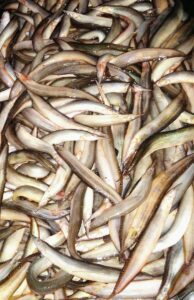Influenza B viruses, unlike influenza A viruses, do not cause pandemics. There are many non-human animal reservoirs of influenza A viruses which provide gene segments that go towards making reassortant viruses that can infect humans. Influenza B viruses do not appear to have an animal reservoir other than humans – they have been isolated from seals but these appear to be human viruses. Influenza viruses discovered in fish and amphibians, however, are clearly not human viruses.
A sampling of viruses in amphibians, fish, and reptiles revealed influenza B virus sequences in the spiny eel, hagfish, and Asiatic toad. An important question to answer is whether these putative viruses have to potential to donate RNA segments to viruses that infect humans. To answer this question, functions of the HA and HA proteins of Wuhan spiny eel influenza virus (WSEIV) were studied. These two glycoproteins, found in the viral membrane, are important determinants of host range.
The HA protein of influenza A and B viruses binds the cell receptor, sialic acid, and catalyzes membrane fusion. These viruses can also hemagglutinate red blood cells. The HA protein of WSEIV does not hemagglutinate red blood cells. Influenza virus HA binds alpha2,3 and alpha2,6 linked silica acids, but the WSEIV HA binds alpha2,3 sialic acids only when they are present in a ganglioside – a sialic acid-containing lipid. HA cleavage by cell proteases is required for fusion, but none of the human airway proteases that cleave influenza A or B virus HA cleave WSEIV HA. Furthermore, the HA of WSEIV cannot catalyze fusion of cells in culture. It is therefore functionally divergent from other influenza virus HA proteins.
In contrast, the NA protein of WSEIV does have neuraminidase activity – the ability to cleave sialic acid from glycoproteins – as do other influenza virus NA proteins. Furthermore, the NA of WSEIV has similar biochemical properties as the NA of other influenza viruses, and its activity can be inhibited by the antiviral drug Tamiflu.
Both the HA and NA proteins of WSEIV are antigenically diverged from other influenza viruses – they do not react with a panel of monoclonal antibodies directed against influenza B viruses. Furthermore, human sera do not appear to contain antibodies that bind the WSEIV HA or NA, indicating that humans have not been infected with this virus.
These data show that WSEIV is a bona fide influenza virus; the HA is functionally diverged from that of other influenza viruses while the NA has similar properties. Based on these observations it seems unlikely that the WSEIV HA RNA segment could be part of a virus that infects humans. However, the similarity of the WSEIV NA with those of other influenza viruses suggest that it might be compatible with reproduction in humans. The fact that there is little antigenic conservation of the WSEIV glycoproteins with those of other influenza viruses means that an influenza virus carrying them would encounter an immunologically naive human population. Sound familiar?
An important lesson of this work is that we have woefully undersampled wildlife for viruses. Consequently, conclusions about what viruses are found in which hosts are likely to be wrong.


Prof Vincent Racaniello, Thank you very much for one more text, I read and translate all of them into Portuguese, sharing them on my social media. If you allow me two observations in relation to this text, HA came out twice in the link to the manuscript. And it lacked to describe, for people who are not from this study area, that HA stands for hemagglutinin and NA for neuraminidase. Also when talking about rearrangement I would put it in parentheses (the genome of the Influenza virus is segmented, that’s why rearrangements occur). Best regards, Fabricio.
All the more reason to remember my CsCl remedy for diseases caused by negative-strand RNA viruses. If North Korea or China, or really any country bent on the destruction of mankind starts fooling around with mixing engineered Spiny Eel gene segments into Influenza A backgrounds, who knows what will emerge? There is always room for a new pandemic.
Thank you for featuring our work on your blog, Dr. Racaniello! This is a wonderful summary of our findings. To follow up, the receptor, GM2, distribution for this virus is largely restricted to cancerous and neuronal tissues in humans. For a respiratory virus such as influenza, this receptor distribution may not be advantageous from an infection standpoint. But the other way of looking at this is the targeting capacity for gene therapy interventions specifically targeting neurons (for Tay Sachs disease where GM2 is overexpressed) or cancers for oncolytics. Eddie Holmes’s group also followed up by identifying a few more influenza B-like viruses in non-human hosts, one of which is even closer to influenza B than the spiny eel virus. There’s still so much left for us to learn and study in these undersampled hosts.
I can always learn the latest research from your articles. Thanks!